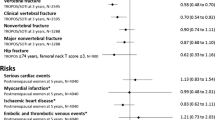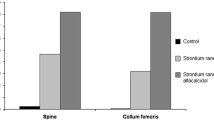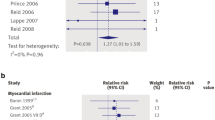Abstract
Strontium ranelate is a novel therapy for the treatment of postmenopausal osteoporosis with actions to reduce bone resorption and increase bone formation. In vitro, strontium ranelate has anabolic and antiresorptive activity, increasing collagen and non-collagen protein synthesis, enhancing pre-osteoblast differentiation, inhibiting osteoclast differentiation, and reducing osteoclast function. In animal models, the increase in bone density is closely correlated with increases in biomechanical bone strength. Histomorphometry demonstrates reduced osteoclast surfaces with increased bone formation. Clinical trials in postmenopausal women have demonstrated 3-year fracture efficacy. Reductions in vertebral fracture were seen in patients with and without prevalent vertebral fracture. Nonvertebral fractures were also significantly reduced. In a subgroup of patients at high risk for hip fracture, there was a significant reduction in hip fracture risk. Strontium ranelate is well tolerated with nausea, diarrhea, headache, and dermatitis more frequent in treated patients only for the first 3 months of therapy. Together, these data suggest that strontium ranelate is a well-tolerated and effective therapy for postmenopausal osteoporosis reducing vertebral and nonvertebral fracture by a novel dual antiresorptive and anabolic action on bone.
Similar content being viewed by others
References and Recommended Reading
Seeman E: Pathogenesis of bone fragility in women and men. Lancet 2002, 359:1841–1850.
Canalis E, Hott M, Deloffre P, et al.: The divalent salt S 12911 enhances bone cell replication and bone formation in vitro. Bone 1996, 18:517–523.
Su Y, Bonnett J, Deloffre P, et al.: The strontium salt S 12911 inhibits the expression of carbonic anhydrase and the vitronectin receptor in chicken bone marrow cultures and bone resorption in mouse calvaria and isolated rat osteoclasts. J Bone Miner Res 1992, 7(Suppl1):S306.
Arlot ME, Roux JP, Boivin G, et al.: Effects of strontium salt (S 12911) in both tibial metaphysis and epiphysis in normal growing rats [abstract]. J Bone Miner Res 1995, 10(Suppl_1):M415.
Buehler J, Chappuis P, Saffar JL, et al.: Strontium ranelate inhibits bone resorption while maintaining bone formation in alveolar bone in monkeys (Macaca fascicularis). Bone 2001, 29:176–179.
Boivin G, Deloffre P, Perrat B, et al.: Strontium distribution and interactions with bone mineral in monkey iliac bone after strontium salt (S12911) administration. J Bone Miner Res 1996, 11:1302–1311.
Ammann P, Shen V, Robin B, et al.: Strontium ranelate improves bone resistance by increasing bone mass and improving architecture in intact female rats. J Bone Miner Res 2004, 19:2012–2020.
Ammann P: Strontium ranelate: a novel mode of action leading to renewed bone quality. Osteoporos Int 2005, 16(Suppl1):S11–15. A recent summary of the evidence for a novel mechanism of action of strontium ranelate on bone involving suppression of bone resorption and stimulation of bone formation.
Marie PJ, Hott M, Modrowski D, et al.: An uncoupling agent containing strontium prevents bone loss by depressing bone resorption and maintaining bone formation in estrogen-deficient rats. J Bone Miner Res 1993, 8:607–615.
Marie PJ, Hott M, Modrowski D, et al.: An uncoupling agent containing strontium prevents bone loss by depressing bone resorption and maintaining bone formation in estrogen-deficient rats. J Bone Miner Res 1993, 8:607–615.
Reginster JY, Deroisy R, Dougados M, et al.: Prevention of early postmenopausal bone loss by strontium ranelate: the randomized, two-year, doublemasked, dose-ranging, placebo-controlled PREVOS trial. Osteoporos Int 2002, 13:925–931.
Meunier PJ, Slosman D, Delmas PD, et al.: Strontium ranelate: dose-dependent effects in established post menopausal vertebral osteoporosis. The Stratos 2-year randomized placebo controlled trial. J Clin Endocrinol Metab 2002, 87:2060–2066.
Meunier PJ, Roux C, Seeman E, et al.: The effects of strontium ranelate on the risk of vertebral fracture in women with postmenopausal osteoporosis. N Engl J Med 2004, 350:459–468. In women at high risk for vertebral fracture (low bone density and prevalent vertebral fracture), strontium ranelate significantly reduces the risk for future fracture. The medication is well-tolerated.
Reginster JY, Seeman E, De Vernejoul MC, et al.: Strontium ranelate reduces the risk of nonvertebral fractures in postmenopausal women with osteoporosis: treatment of peripheral osteoporosis (TROPOS) Study. J Clin Endocrinol Metab 2005, 90:2816–2822. This study demonstrates the efficacy and tolerability of strontium ranelate in preventing nonvertebral as well as vertebral fractures in elderly postmenopausal women, including the prevention of hip fractures in women at high risk.
Arlot ME, Delmas P, Burt-Pichat B, et al.: The effects of strontium ranelate on bone remodeling and bone safety assessed by histomorphometry in patients with postmenopausal osteoporosis. Paper presented at the annual meeting of the ASBMR. Nashville, TN, September 24–27, 2005.
Pors-Nielsen S, Slosman D, Sorensen OH, et al.: Influence of strontium on bone mineral density and bone mineral content measurements by dual x-ray absorptiometry. J Clin Densitom 1999, 2:371–379.
Dahl SG, Allain P, Marie PJ, et al.: Incorporation and distribution of strontium in bone. Bone 2001, 28:446–453.
Boivin G, Schenker E, Tupinon-Mathieu I, Meunier PJ: Uptake and distribution of strontium in human bone, evolution of the degree of mineralisation after strontium ranelate administration. J Bone Miner Res 1999, 14(Suppl1):284.
Boivin G, Deloffre P, Perrat B, et al.: Strontium distribution and interactions with bone mineral in monkey iliac bone after strontium salt (S 12911) administration. J Bone Miner Res 1996, 9:1302–1311.
Nielsen SP, Slosman D, Sorensen OH, et al.: Influence of strontium on bone mineral density and bone mineral content measurements by dual x-ray absorptiormetry. J Clin Densitom 1999, 2:371–379.
Author information
Authors and Affiliations
Corresponding author
Rights and permissions
About this article
Cite this article
Kendler, D.L. Strontium ranelate—Data on vertebral and nonvertebral fracture efficacy and safety: Mechanism of action. Curr Osteoporos Rep 4, 34–39 (2006). https://doi.org/10.1007/s11914-006-0013-6
Issue Date:
DOI: https://doi.org/10.1007/s11914-006-0013-6




